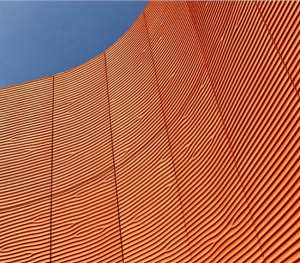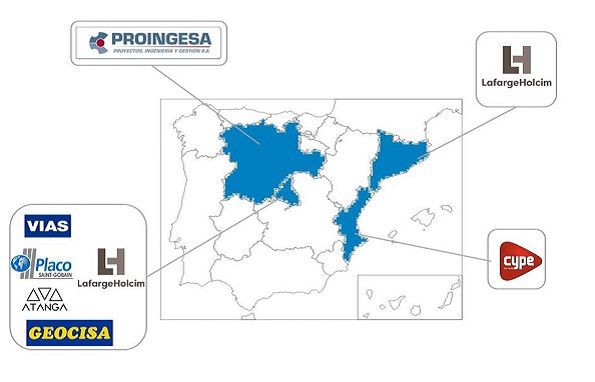These days, 3D printing is frequently used in construction, and we’ve just learned of a new project that has a goal of further introducing the technology into the industry, specifically in both restoration and rehabilitation and in new construction. The final application of the 3DCONS project will be focused on rehabilitating façades, which have been created with 3D printing before, in addition to using direct 3D printing – no formwork or molds – to restore architectural elements, vertical surfaces, and developing systems that can 3D print pre-fabricated elements à la carte, so they can adhere to specific, necessary requirements about features such as thickness, shape, and acoustic and thermal properties.
“To take advantage of the possibilities offered by these new materials and application methods specific design tools based on Building Information Modelling (BIM) will be developed,” the 3DCONS website reads. “These tools will overcome current restrictions on “multilayer” and “by catalogue” construction by providing new building systems in which the optimal shapes, dimensions and features are applied in each element and area of the building.”
The 3DCONS project was implemented by a consortium of eight companies – each a leader in its own field – and five cooperating research centers.
There are several project objectives, such as developing robotic 3D printing systems to automate rehabilitation and construction, creating new building processes that collect data in order to apply new building and design systems, and making new materials, based on cement, gypsum, and lime, specifically for use in extrusion-based 3D printing processes.
Additional objectives include:
- decreasing occupational hazards
- lowering the associated carbon footprint
- fully integrating BIM into the construction process
- customizing construction and developing new systems and methodologies
- revolutionizing the industry “from within” as opposed to using external agents
- creating technological developments, like 3D printing in the vertical plane, that can be transferred to other sectors
 The 3DCONS project has been organized into five specific activities, starting with Conceptual Design Specifications.
The 3DCONS project has been organized into five specific activities, starting with Conceptual Design Specifications.
“The purpose of this activity is the preliminary analysis to obtain an understanding of the initial requirements and specifications that will serve as a starting point to develop advanced construction processes using 3D printing,” the 3DCONS website explains.
The second activity is Materials, and will focus on developing new formulations and materials. The consortium will study the 3D printing of gypsum-based materials and composites “in paste for the construction of unique prefabricated elements with complex shapes,” in addition to cement and lime-based materials. A fire-resistant, non-structural material with low thermal conductivity will be developed for vertical use with a robotic construction system, and the consortium will also create a dry concrete that can be used in extrusion-based 3D printing to create unique pieces for heritage building rehabilitation.
Hardware and Automation is the third 3DCONS activity, with a dual goal of creating the conceptual design for new 3D printers and analyzing the possibilities that could result from automating construction processes, like on-site new building construction.
“In Activity 4, a whole new technology for the constructive and energy characterization of facades, which can be carried out quickly and economically, will be developed,” the website says about the New Design Tools and ICT Systems activity. “Subsequently, the new tools developed will allow for the design of the intervention and elements to be printed, based on the analysis performed. Among other technologies, we will use geometric 3D laser measurement technology and parameterized analysis of the energy and acoustic performance of the facade.”
 The consortium will collect construction data in order to calculate acoustic performance and energy efficiency, in addition to geometric measurements for designing new façades. With this activity, the 3DCONS project hopes to develop new tools for building performance simulation, new design processes that take advantage of modern technologies like BIM, thermography, and 3D scanning, and procedures for information submission.
The consortium will collect construction data in order to calculate acoustic performance and energy efficiency, in addition to geometric measurements for designing new façades. With this activity, the 3DCONS project hopes to develop new tools for building performance simulation, new design processes that take advantage of modern technologies like BIM, thermography, and 3D scanning, and procedures for information submission.
The fifth and final activity of the 3DCONS project, Integration and Demonstration of Concepts, is a result of “the R&D lines” that were developed in the second, third, and fourth activities. The consortium will carry out a variety of demonstrators, via case studies, in order to “validate the technology and demonstrate its potential.”
Two prototype 3D printers, three new material families, and new analysis and design tools will be built and used as part of this final activity. The consortium expects that this will result in the integration of new 3D printing construction processes, an analysis of the processes’ life cycles, and validation of the processes “developed through information and full-scale tests conducted on the demonstrators of different construction processes.”
Discuss this news and other 3D printing topics at 3DPrintBoard.com or share your thoughts below.
[Images: 3DCONS]Subscribe to Our Email Newsletter
Stay up-to-date on all the latest news from the 3D printing industry and receive information and offers from third party vendors.
You May Also Like
Gorilla Sports GE’s First 3D Printed Titanium Cast
How do you help a gorilla with a broken arm? Sounds like the start of a bad joke a zookeeper might tell, but it’s an actual dilemma recently faced by...
Nylon 3D Printed Parts Made More Functional with Coatings & Colors
Parts 3D printed from polyamide (PA, Nylon) 12 using powder bed fusion (PBF) are a mainstay in the additive manufacturing (AM) industry. While post-finishing processes have improved the porosity of...
$25M to Back Sintavia’s Largest Expansion of Metal 3D Printing Capacity Since 2019
Sintavia, the digital manufacturing company specializing in mission-critical parts for strategic sectors, announced a $25 million investment to increase its production capacity, the largest expansion to its operations since 2019....
Velo3D Initiates Public Offering in a Bid to Strengthen Financial Foundations and Drive Future Growth
Velo3D (NYSE: VLD) has been among a number of publicly traded 3D printing firms that have attempted to weather the current macroeconomic climate. After posting a challenging financial report for 2023,...

































